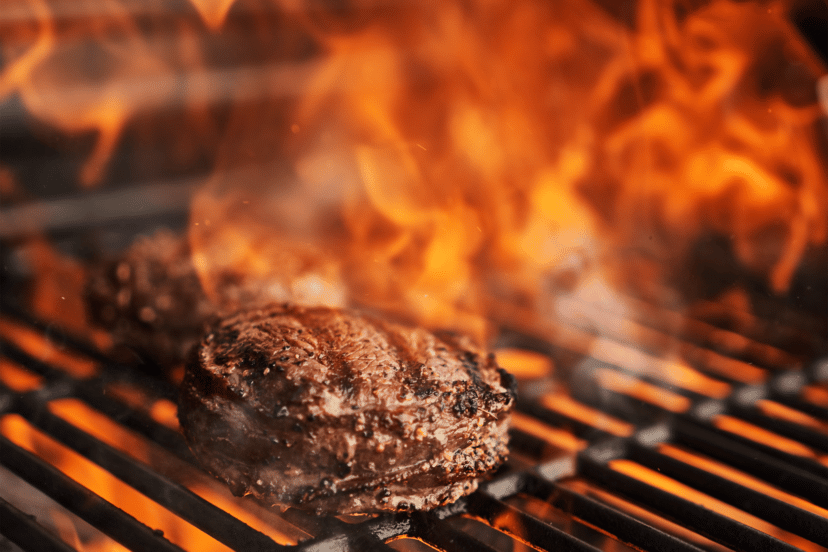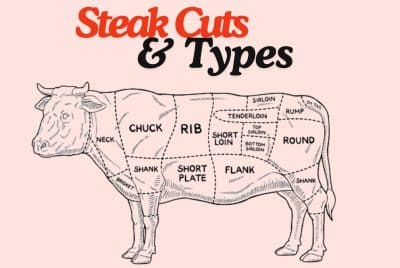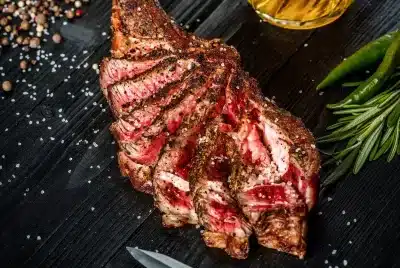Ideal Temperatures for Searing Steak
If you’ve ever wrestled with the question of “what temperature to sear a steak,” then you’re not alone. It’s an art that often leaves us with either a dry, overcooked meal or an undercooked steak that lacked that perfect sear.
This article will provide essential insights into the ideal temperatures for searing different cuts of steak, steering you clear of potential cooking pitfalls. Let’s dive into the world of steaks and see how we can guarantee delectable meals every time!
Table of Contents
Key Takeaways
- The ideal temperature for searing steak is between 450°F and 500°F (232°C to 260°C).
- It’s important to sear the steak at the right temperature to achieve a delicious crust without overcooking or undercooking.
- Different levels of doneness require different internal temperatures: medium-rare (130-135°F), medium (135-145°F), and medium-well (145-155°F).
- Factors such as the thickness and cut of the steak, type of cooking surface, and personal preferences for doneness can influence searing temperatures.
The Importance of Temperature in Searing Steak
Achieving a perfect sear on your steak and avoiding the dreaded overcooking or undercooking depends heavily on getting the temperature just right.
Achieving a perfect sear
Unleashing the true flavor of your steak lies in achieving that perfect sear. It’s a delicate art that hinges on manipulating temperatures at just the right moment. The key is to initially set your stove or grill’s heat high, ideally between 450°F and 500°F as this temperature range proves most effective for creating a delectable crust with an irresistible bouquet of aromas.
Too low, and you risk overcooking your steak without getting that rich browned surface; too high, like above 500°F, you are likely to end up with dry meat — neither scenario ideal for a gastronomic delight.
It’s crucial to have control over these elements: start by placing the steak on preheated grill or pan and enclose it directly under the lid during searing to concentrate the heat. Limiting searing time between 2-3 minutes per side is sensible depending on how well-done you fancy your steak.
Thus carefully juggling these variables ensures each bite into your perfectly-seared steak gratifies every taste bud.
Avoiding overcooking or undercooking
Achieving the perfect sear on a steak is not just about creating a delicious crust, but also ensuring that it’s cooked to your desired level of doneness. By searing at the right temperature, you can avoid the pitfall of overcooking or undercooking your steak.
Overcooking can result in a dry and tough piece of meat, while undercooking may leave you with an unpleasantly raw center.
To achieve the ideal sear and prevent these cooking mishaps, it’s important to know the recommended temperatures for different levels of doneness. For a juicy medium-rare steak with a slightly pink center, aim for an internal temperature of 130-135°F (54-57°C).
If you prefer your steak cooked to medium with some pinkness remaining in the center, target 135-145°F (57-63°C). And if you prefer a more well-done steak with little to no pinkness left, go for 145-155°F (63-68°C).
By following these temperature guidelines and using a reliable meat thermometer to check doneness accurately, you can ensure that each bite of your perfectly seared steak delivers both amazing flavor and ideal texture.
Recommended Temperatures for Searing Steak

To achieve the perfect sear on your steak, it’s important to know the recommended temperatures for each level of doneness: medium-rare should be cooked to 130-135°F (54-57°C), medium to 135-145°F (57-63°C), and medium-well to 145-155°F (63-68°C).
Medium-rare: 130-135°F (54-57°C)
For a perfectly cooked medium-rare steak, you’ll want to sear it at a temperature between 130-135°F (54-57°C). This is the sweet spot where the steak will have a warm pink center with a nice crust on the outside.
Cooking the steak to this temperature allows for optimal tenderness and juiciness, ensuring that you don’t end up with an overcooked or undercooked piece of meat. Keep in mind that achieving the ideal searing temperature requires preheating your pan or grill to around 450°F to 500°F and cooking the steak for about 2 to 3 minutes per side.
By following these guidelines, you’ll be able to enjoy a mouthwatering medium-rare sear on your steak every time.
Medium: 135-145°F (57-63°C)
Medium, with a temperature range of 135-145°F (57-63°C), is the perfect balance for those who enjoy a steak that is juicy and slightly pink in the center. This temperature allows the meat to cook through while retaining its tenderness and natural flavors.
Searing your steak at this medium temperature ensures that it develops a beautiful crust on the outside without overcooking or drying out the inside. Achieving this temperature requires preheating your cooking surface, whether it’s a pan or grill, to around 450-500°F (232-260°C) before adding your steak.
Using a reliable meat thermometer will help you determine precisely when your steak reaches the desired medium doneness. Remember, cooking time may vary depending on factors such as thickness and personal preference for doneness, so keep an eye on your thermometer throughout the searing process to ensure perfection every time.
Medium-well: 145-155°F (63-68°C)
For those who prefer their steak cooked a bit more, the medium-well temperature range is ideal. At this level of doneness, the interior of the steak will have a hint of pink and be firmer to the touch.
The temperature range for achieving a medium-well sear on your steak is between 145-155°F (63-68°C). It’s important to note that cooking your steak beyond medium-well can result in a drier texture and less juiciness.
To achieve the perfect medium-well sear, preheat your grill or pan to around 450°F to 500°F. This high heat helps create that delicious brown crust on the outside while retaining moisture on the inside.
Place your seasoned steak onto the hot surface, close the lid if using a grill, and let it sear for about 2 to 3 minutes per side.
Always remember that factors such as thickness and cut of the steak, as well as personal preferences for doneness, can influence cooking times and temperatures. Using a reliable meat thermometer ensures accuracy when determining whether your steak has reached its desired temperature.
Tips for Achieving the Ideal Searing Temperature
To achieve the ideal searing temperature, make sure to preheat your pan or grill for several minutes before adding the steak. Use a reliable meat thermometer to monitor the temperature and ensure it reaches the desired range.
Additionally, allow the steak to come to room temperature before searing for more even cooking.
Preheating the pan or grill
To achieve the perfect sear on your steak, it’s crucial to preheat your pan or grill before cooking. This step ensures that the surface reaches the optimal temperature for searing, allowing you to lock in those delicious flavors.
Preheating at a high temperature between 450°F and 500°F is ideal for creating a beautiful brown crust on your steak. It’s important to give your pan or grill enough time to heat up properly, so be patient and allow it to reach the desired temperature before placing your steak on it.
By preheating correctly, you’ll ensure that each side of the steak gets evenly caramelized while keeping the meat juicy and tender within.
Using a reliable meat thermometer
To ensure that you sear your steak at the perfect temperature, it’s vital to use a reliable meat thermometer. This tool will help you accurately gauge the internal temperature of the steak, allowing you to achieve your desired level of doneness.
Insert the thermometer into the thickest part of the meat without touching any bone for an accurate reading. By using a meat thermometer, you can avoid undercooking or overcooking your steak and ensure that it’s perfectly seared to perfection.
Don’t rely solely on guesswork; invest in a good quality meat thermometer for consistent, delicious results every time.
Allowing the steak to come to room temperature before searing
Before searing your steak, it’s important to allow it to come to room temperature. This simple step can greatly impact the overall cooking process and ensure a perfectly cooked steak. When meat is taken directly from the fridge and placed on high heat, it tends to cook unevenly, with a well-done exterior and an undercooked center.
By allowing the steak to sit at room temperature for about 30 minutes before searing, you give it time to warm up evenly.
When a steak is closer in temperature throughout, it cooks more evenly and results in a juicier end result. The internal temperature will rise more consistently during cooking, ensuring that the steak’s exterior and interior are cooked just right.
Factors That Influence Searing Temperatures
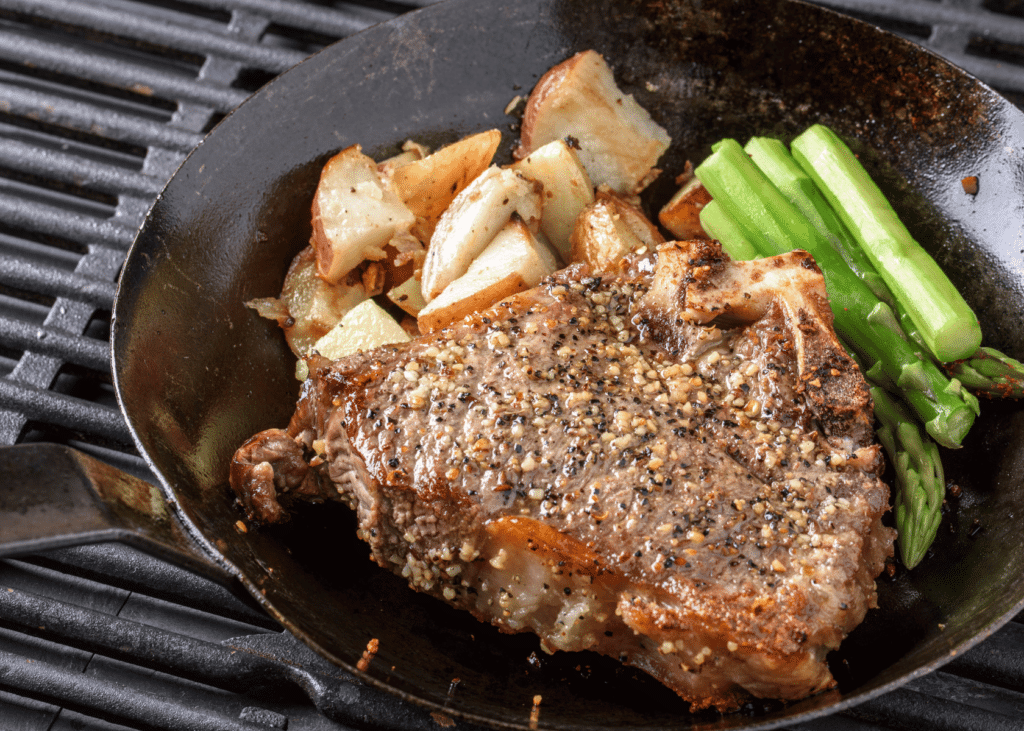
Several factors can influence the ideal searing temperature for your steak. From the thickness and cut of the steak to the type of cooking surface you’re using, these variables play a significant role in determining the perfect sear.
Discover more about these influential factors that will help you achieve restaurant-quality results when searing your steak. Read on to learn how to master the art of searing!
Thickness and cut of the steak
The thickness and cut of the steak play a crucial role in determining the ideal searing temperature. Thicker cuts, such as ribeye or porterhouse, require a lower searing temperature compared to thinner cuts like skirt or flank steak.
Thicker steaks need more time to cook evenly while still achieving that perfect sear on the outside. On the other hand, thinner steaks can be cooked at higher temperatures for a shorter duration without overcooking them.
So, consider both the thickness and cut of your steak when determining the optimal searing temperature for that delicious caramelized crust.
Type of cooking surface (cast iron, grill, etc.)
The type of cooking surface you use can greatly impact the searing temperature for your steak. A cast iron skillet is an excellent choice for achieving a high, even heat that helps create a perfect crust on your steak.
The heavy construction of cast iron allows it to retain heat well, resulting in a consistent and reliable sear every time.
On the other hand, grilling is another popular method for searing steaks. Gas grills provide precise temperature control, allowing you to easily adjust the heat according to your desired doneness.
Charcoal grills offer a smoky flavor that many steak enthusiasts enjoy, but it’s important to note that they may take longer to preheat and maintain a consistent temperature compared to gas grills.
Personal preferences for doneness
One important factor to consider when searing steak is your personal preference for doneness. The temperature at which you sear your steak will determine how well-cooked it is on the inside.
Some people prefer their steaks to be medium-rare, with a warm red center and a slightly pink interior. For this level of doneness, aim for an internal temperature of about 130-135°F (54-57°C).
Others may prefer their steaks to be medium, with a bit more pink in the middle and a warmer center. In that case, you’ll want to sear your steak until it reaches an internal temperature of approximately 135-145°F (57-63°C).
If you like your steaks more well-done, with minimal traces of pink in the middle, then aim for temperatures between 145-155°F (63-68°C) during the searing process. Ultimately, finding the perfect balance between achieving a flavorful crust and maintaining desired doneness is key when it comes to determining what temperature to sear your steak at.
Frequently Asked Questions
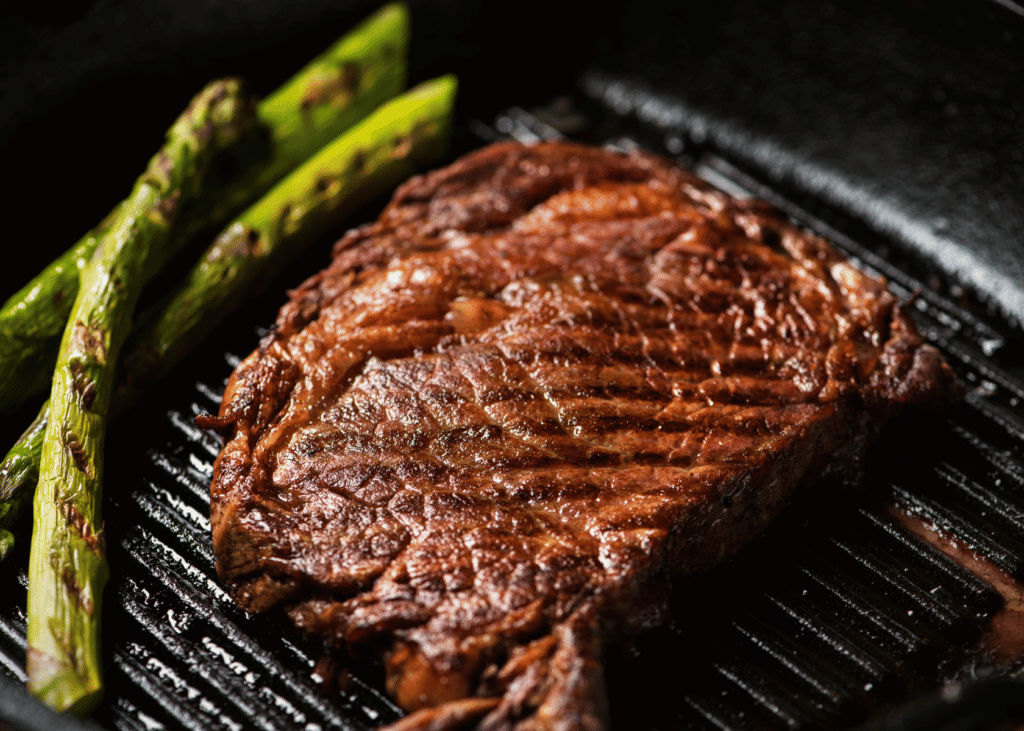
1. What temperature should I use to sear a steak?
For the perfect sear on a steak, you’ll want to preheat your skillet or grill to a high temperature of around 450-500 degrees Fahrenheit (230-260 degrees Celsius).
2. How long should I sear a steak for?
The exact time will depend on the thickness of your steak and how well done you prefer it. As a general guideline, aim for about 2-4 minutes per side for medium-rare doneness.
3. Should I use oil or butter when searing a steak?
It is recommended to use an oil with a high smoke point such as canola, vegetable, or avocado oil when searing steaks. Butter has a lower smoke point and may burn before achieving the desired sear.
4. Can I sear frozen steaks?
While it is possible to sear frozen steaks, it is generally recommended to thaw them first for more even cooking. Searing frozen steaks can result in uneven heat distribution and longer cooking times.
Final Thoughts and Additional Tips for Searing Steak
In conclusion, knowing the right temperature to sear your steak is essential for achieving that perfect caramelized crust while keeping the interior juicy and tender. Aim for a searing temperature of 450°F to 500°F (232°C to 260°C) and use a reliable meat thermometer to ensure the desired doneness.
Preheat your cooking surface, whether it’s a pan or grill, and allow your steak to come to room temperature before searing. By following these tips, you’ll be well on your way to serving up a beautifully seared steak that will impress every time.
Happy grilling!
Conclusion
In conclusion, achieving the perfect sear on your steak is all about finding the right temperature. For a medium-rare steak, aim for a temperature of 130-135°F (54-57°C), while medium-cooked steaks should be seared at 135-145°F (57-63°C).
Remember to preheat your pan or grill, use a reliable meat thermometer, and let the steak come to room temperature before searing. By considering these factors and following these tips, you’ll be able to enjoy a beautifully seared and flavorful steak every time.
Happy cooking!
*We may earn a commission for the purchases made using our links. Please see our disclosure to learn more.

